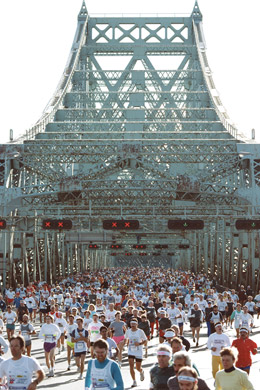 |
 |
 |
Crossing the finish line As marathons and other events grow in popularity, having the right coverage is key By Phil Zinkewicz “The cool breeze lightly touched my face, drying the small beads of sweat that were beginning to form on my forehead. I looked straight ahead, trying to ignore the noise of the crowds who had come to witness the event. This was the day I had been preparing for my whole life. It was the national championship marathon, and I was the only finalist from our school to qualify for the competition. I swallowed, took a deep breath and then listened for the sound of the starting gun.” * * * * * * * * * * “Anyone who has watched or participated in a marathon will quickly notice that not all runners are alike. Some gracefully float by with the finesse of a beautiful swan. Others hobble along like a three-legged donkey. Still others slowly move down the track as if they are on their way to a funeral.” * * * * * * * * * * “Marathon. The word itself produces excitement or fear in the minds of many people. Most enjoy watching others participate but would never think of getting involved themselves. Actually a marathon can be an enjoyable and rewarding experience if you know how to prepare for it. Preparation, of course, does not begin the day before the event. It is a process that involves months, even years of training.” The above statements represent the opening paragraphs of articles that have been written about marathon running. Whether one is a seasoned runner in peak condition, a hesitant neophyte or simply a spectator, a marathon offers challenge, excitement and drama. As the Boston or New York Marathon is being televised, we noncompetitors sit back on our couches, perhaps stuffing ourselves with potato chips and drinking beer while we watch those with a more healthful regime pound the pavement in synchronized running, or sometimes not so synchronized. At any time of the year, in any part of the world, you’re likely to find marathon events or variations on the theme. The story goes that today’s marathon takes its name from a famous ancient battle in which the Athenians were victorious over the Persians in 490 B.C. The battle was at a placed named Marathon and, after the victory, a Greek soldier and champion runner named Pheidippides volunteered to run 25 miles from Marathon to Athens to bring home the good news. When he arrived in Athens, Pheidippides was said to have gasped, “Rejoice, we conquer!” after which he collapsed and died of exhaustion. Pheidippides may have been a champion runner in the eyes of the ancient Greeks, but by today’s runners’ standards either he or the roads were terribly out of shape. He was even one mile short of the 26-mile marathons that take place today. Furthermore, today’s professional runners or even just running enthusi-asts often think that merely running that 26 miles isn’t challenging enough, and they keep pushing the envelope. Consider the following annual events: • Everest Marathon—Considered the “highest” marathon, the location for this November event is Everest Base Camp, Nepal. Started in 1987, the race begins at 17,000 feet. (One wonders whether runners in this race are further hampered by having to wear special breathing apparatus.) • Le Marathon des Chateaux du Medoc—Called “the most indulgent marathon,” this race also takes place in November, and the course passes many of the greatest chateaux in Bordeaux. During the race, runners are expected to drink wine instead of water and eat foie gras instead of bananas. (You’ve got to admit, those French have their priorities straight.) • The Marathon des Sables—This race is considered the “hottest” marathon, and it takes place in April in the Sahara Desert, Morocco. Midday temperatures can reach up to 120 degrees F. (Runners get a nice tan, too.) • Siberian Ice Marathon—This has been called the “coldest” marathon. It takes place in January in Omsk, Russia. The race first started in 1991, but the coldest race was in 2001, when the temperature dropped to 39 degrees below zero. (Thermal underwear optional.) Racing for a cause Of course, not all marathons are this exotic—and not all races are marathons. Many of the races we see being publicized today—especially on the local level—are shorter events like 5K and 10K runs or “fun runs” and walks for nonprofit organizations or charities, such as breast cancer, lung cancer, arthritis and so on. Members of the general public are invited to participate in a run. Participants either pay an entry fee themselves or seek the sponsorship of family and friends, for either the entry fee or a specific sum that is sometimes based on the distance run. When the event is over, the participants go to their sponsors to collect the money and turn it over to the nonprofit or charity. Events like the Susan B. Komen Race for the Cure, held annually in June in cities throughout the country to benefit breast cancer research, draw thousands of participants and volunteers. Police direct traffic and maintain crowd control; emergency medical facilities are on site. Celebrities and local dignitaries attend opening ceremonies and awards presentations. Publicity is professional, sophisticated, and widespread, and the pre-race, race and post-race phases garner broad television and print media coverage. At the local level, members of a community, neighborhood or religious organization may sponsor a run or other event to raise money for a cause—for example, an injured war veteran, accident victim or person with a serious disease, or for a school trip, athletic uniforms or band instruments. Advertising for the event is usually minimal, so the sponsoring entity can handle the expenses. Promotion usually consists of posters being displayed in commercial establishments in the local neighborhood or fliers being handed out, but it’s usually word of mouth by volunteers that gets the most attention. The most popular marathons or shorter runs involve running or walking. But that doesn’t dissuade some “marathoners” from being more inventive. There are dance-a-thons, where people are required to keep dancing for a specific period of time. Also popular are sew-a-thons, where people sew, quilt or craft for a pre-set period of time or until specific numbers of items have been crafted. The added bonus of this kind of event is that, in addition to the money raised, the items crafted can be sold and the money given to the sponsoring entity. There are also exercise-a-thons, clean-a-thons (in keeping with the “green” thing, participants clean up city streets and highways) and cook-a-thons. One of the more inventive of these “designer” marathons is the kiss-a-thon, in which participants must kiss for a specific period of time. (Winners at this kind of event might also be eligible for the world book of records.) Insuring the run Michael Dean of Francis L. Dean & Associates, a managing general underwriter (MGU) in Wheaton, Illinois, knows about the varieties of “thons” out there. His agency insures them, whether public or private. Dean’s agency specializes in sports- and student-related risks, which include leagues, tournaments, camps, all-star events and alumni gatherings. “Every game is a big game,” says Dean. “Whether it is a regularly scheduled season game or a week-long sports camp, amateur athletics is always the site for intense competition. Athletes are often asked to compete at their highest levels and, as a result, are more likely to run the risk of injury.” During marathons or shorter runs, athletes are literally “running” the risk of injury, according to Dean. “There is always the possibility of accidents,” he says. “A twisted ankle or a fall that results in a broken leg can result in serious medical bills. Not only that, but a runner can slip on signs or other promotional materials from advertisers—local banks, mortgage companies, restaurants, etc.—that may litter the ground at the event. Here you have the possibility of a costly lawsuit.” Dean says that the two main coverages purchased by the sponsors of a marathon or other event are general liability and accident insurance. The accident insurance will pay all the medical bills for an injured athlete, and the general liability coverage protects the marathon sponsors, the venue city or park district against lawsuits. “In the past, liability coverage for all sports events, including marathons, was either too costly, too limited or not available at all,” Dean observes. “Coordinators of these events, then, either had to pay a high premium or run the event without insurance. The liability protection we offer provides overall protection from litigants with no gaps in coverage. We employ an on-staff attorney and paralegals, so that clients are guaranteed their coverage in the event that litigation occurs.” The highlights of the Francis L. Dean & Associates liability program include $1 million limits, $2 million aggregates, occurrence form policies, coverage of athletic participants, coverage of assault and battery, and coverage of sexual abuse and molestation. Dean says that the coverage is relatively inexpensive. “It runs about $4 per participant, or a minimum premium of $450.” In a marathon, Dean says, the length of the event does not add significantly to the exposure, but the number of participants can have an impact. Also, the type of marathon can be an issue, he says. While Dean says he hasn’t insured any dance-a-thons or kiss-a-thons, he did have a marathon exposure involving a “run for animals,” where participants ran with their own leashed pets. He also insured a “big wheel” run, where kids sat inside a big wheel and were pushed in the race. “There has been a significant upsurge in marathon events in the last couple of decades,” says Dean. “People are more aware of the potential hazards of eating fast foods versus the benefits of running long distances. I think the trend will continue.” * |
|
|||||||
|
||||||||

